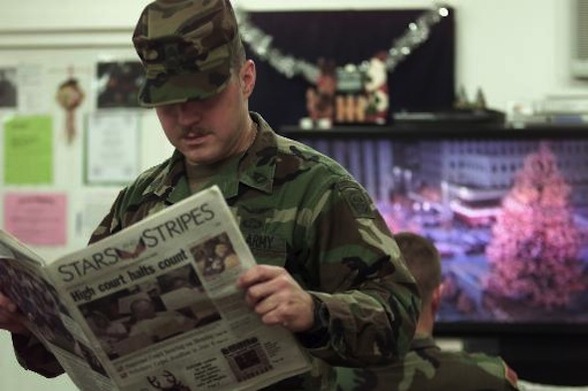 Call of duty US soldier serving in the NATO-led peacekeeping mission in Kosovo reads about the contested 2000 presidential election (AP Photo/Visar Kryeziu)
Call of duty US soldier serving in the NATO-led peacekeeping mission in Kosovo reads about the contested 2000 presidential election (AP Photo/Visar Kryeziu)
The scandal erupting around NBC anchor Brian Williams began with a screenshot. On Tuesday afternoon, Stars and Stripes Editor Terry Leonard was emailed an image of a Facebook thread in which users disputed Williams’ long-told story of experiencing an RPG attack in the Iraq war. One of the commenters had the same name of a source in the newspaper’s coverage of the 2003 incident, and Leonard quickly dispatched a reporter to track down him and others who’d been at the scene.
Turns out — as Stars and Stripes reported alongside Williams’ apology on Wednesday — that America’s most-watched evening newsman had repeatedly misled viewers about riding on a helicopter downed by rocket fire.
“It went very smoothly,” Leonard said of debunking the journalist’s account. “[Williams] was very upfront about the fact that he had blundered.”
Though many other news organizations have since picked up the story, it’s one that few other outlets could have turned around so quickly. Stars and Stripes may be relatively unknown to the vast majority of Americans, but its deep-rooted coverage of the military stretches back most of the past century.
The Pentagon-backed newspaper has suffered from the same economic changes that have plagued the rest of the media industry in recent years, challenges that have been compounded by a diffuse print readership spanning the globe. Subsidies from the Department of Defense, meanwhile, have withered alongside cuts to overall military spending. Those factors have left Stars and Stripes clamoring for new ways to reach US military units. And it must do so while maintaining autonomy from the government agency that supported it to the tune of $7.8 million in 2014, a number that has continued to shrink under government-wide budget cuts known as sequestration.
“If we’ve got troops in Djibouti, we need to get them a newspaper,” Leonard said. “When we look at our role, we have a mandate from Congress to provide soldiers and [Department of Defense] civilians with the kind of independent news and information that allows them to participate in our democracy.”
The relationship between the newspaper and Pentagon is one of inherent tension, as the Department of Defense subsidizes coverage that may very well cast it in a negative light. Despite the financial ties, however, “Stars and Stripes is guaranteed First Amendment privileges that are subject to Congressional oversight,” according to its website. Other military-backed media outlets — the Pentagon Channel and the American Forces Network, for example — aren’t afforded such a luxury.
An ombudsman not only writes for the newspaper, but also acts as a liaison to Congress. “His real job is to make sure [the Department of Defense] doesn’t interfere with our independence,” Leonard said. “I’ve been here for seven years, and there’s never been a problem.”
The paper culls the lion’s share of its revenue from print sales and advertising, printing about 30,000 copies a day for US bases in Europe, the Middle East, and the Pacific, according to Leonard. That’s down from about 100,000 at the height of conflicts in Iraq and Afghanistan. “When the wars end and we bring the troops home, our circulation and [advertising] rates fall as well,” Leonard said.
What’s more, putting out a newspaper in the far corners of the world doesn’t come cheap. While Stars and Stripes’ print edition is sold for 50 cents or handed out for free, Leonard said, production and distribution can total as much as $1.60 a copy. “We got the most dangerous paper routes in the world,” he added.
Printed briefly during the Civil War and temporarily resurrected during World War I, the newspaper has been continuously printed since World War II. Its staff has included the likes of Harold Ross, who later founded The New Yorker, and Grantland Rice, the prolific sportswriter whose name now graces an ESPN-owned sports and culture website. Stars and Stripes won a Polk Award in 2009 for stories on Army PR consultants hired to evaluate journalists in an effort to push them toward positive coverage of the war in Afghanistan.
The newspaper’s well regarded editorial staff has shrunk from about 100 to roughly 80 over the course of Leonard’s seven-year tenure. Yet Stripes.com’s readership has steadily increased to nearly 4.5 million pageviews a month. The newspaper’s Williams scoop has drawn huge audiences to its website — the story won’t appear in print till Friday given early deadlines for international editions — and has garnered nearly 4,000 social shares, according to Muck Rack analytics.
It’s the type of readership that will help Stars and Stripes make the transition with which so many news organizations have grappled. But for Leonard, at least, the Williams revelation is also somewhat bittersweet.
“I’m kind of sad for Mr. Williams,” he said. “I think he has a record of really caring about troops, and then this happens. It is what it is.”
Chris Ip and Lene Bech Sillesen contributed reporting.
David Uberti is a writer in New York. He was previously a media reporter for Gizmodo Media Group and a staff writer for CJR. Follow him on Twitter @DavidUberti.
